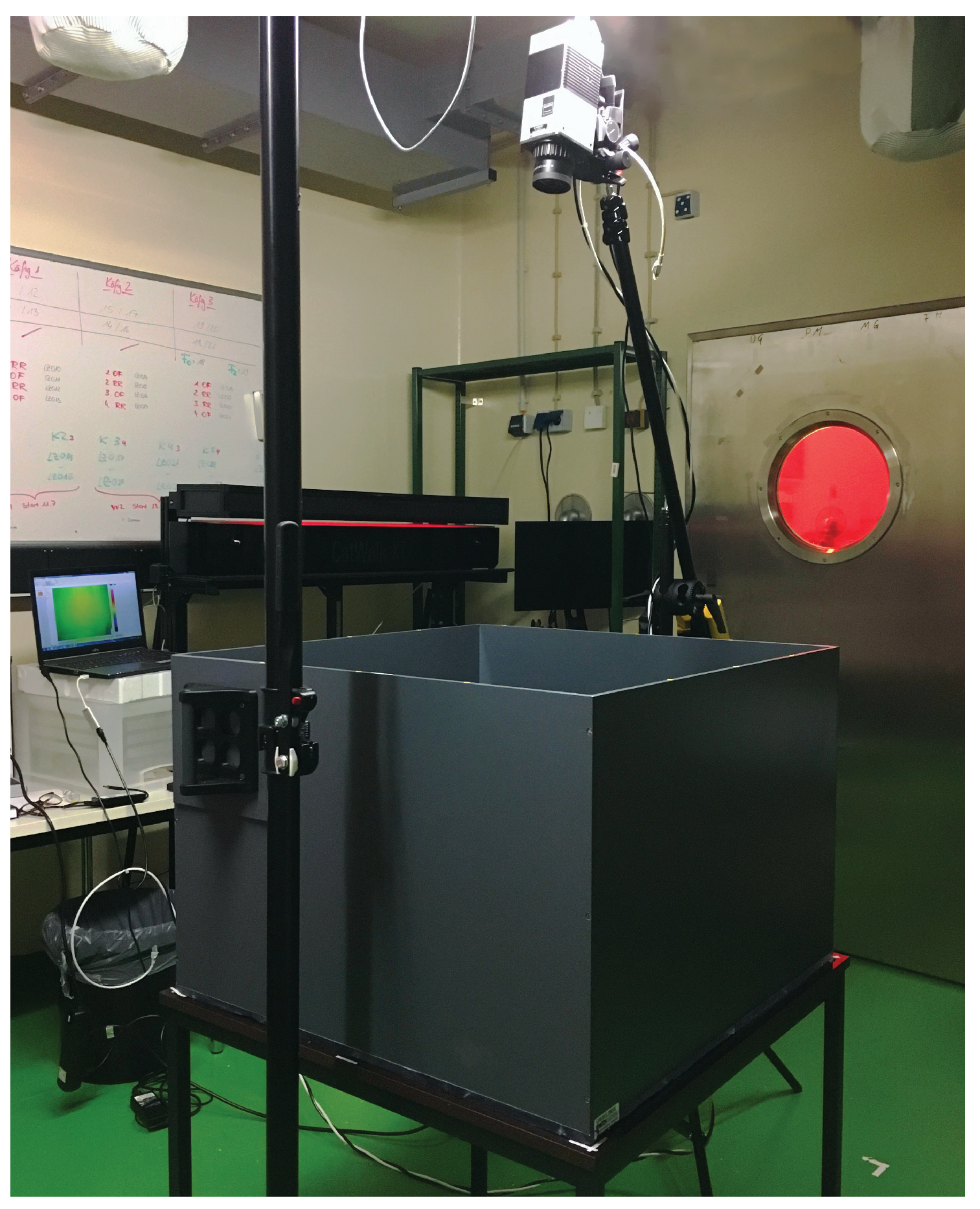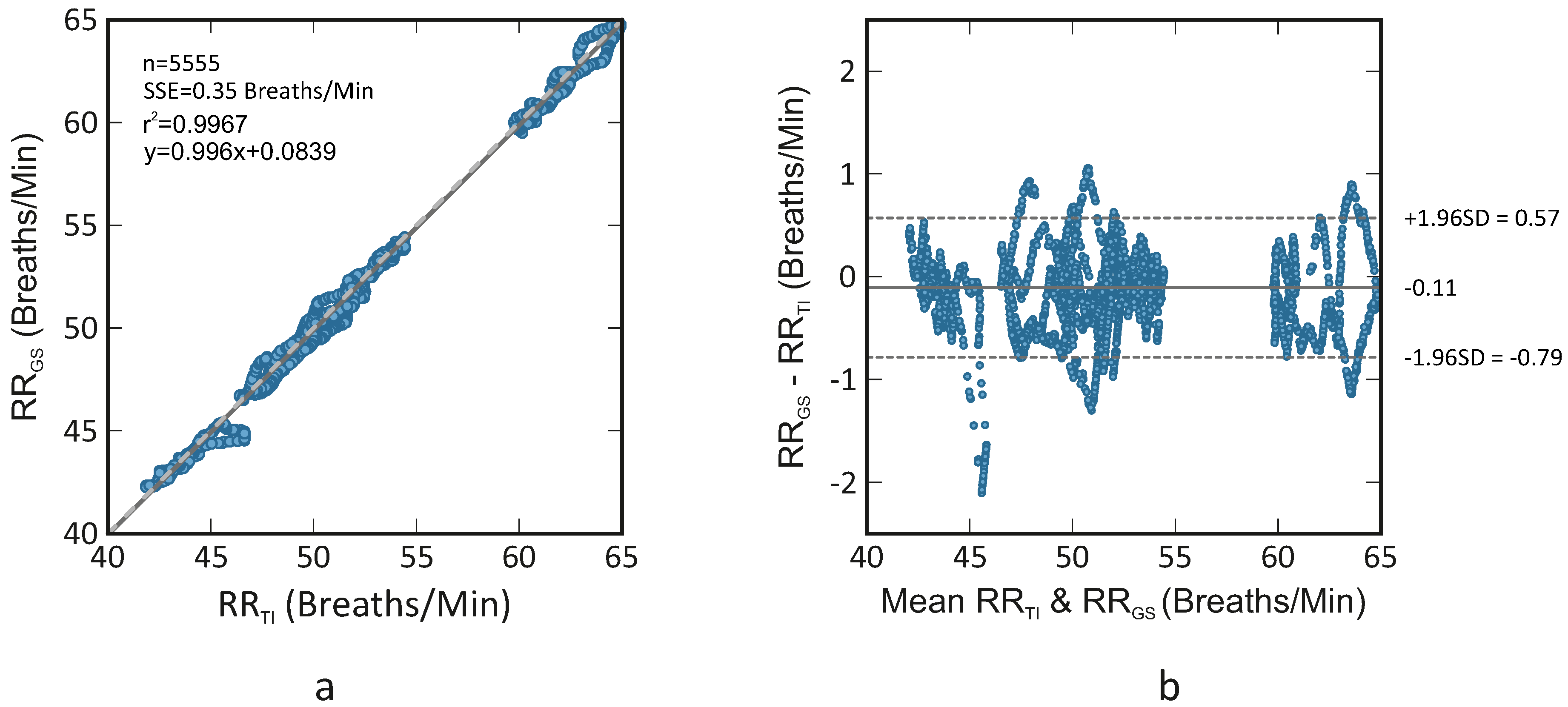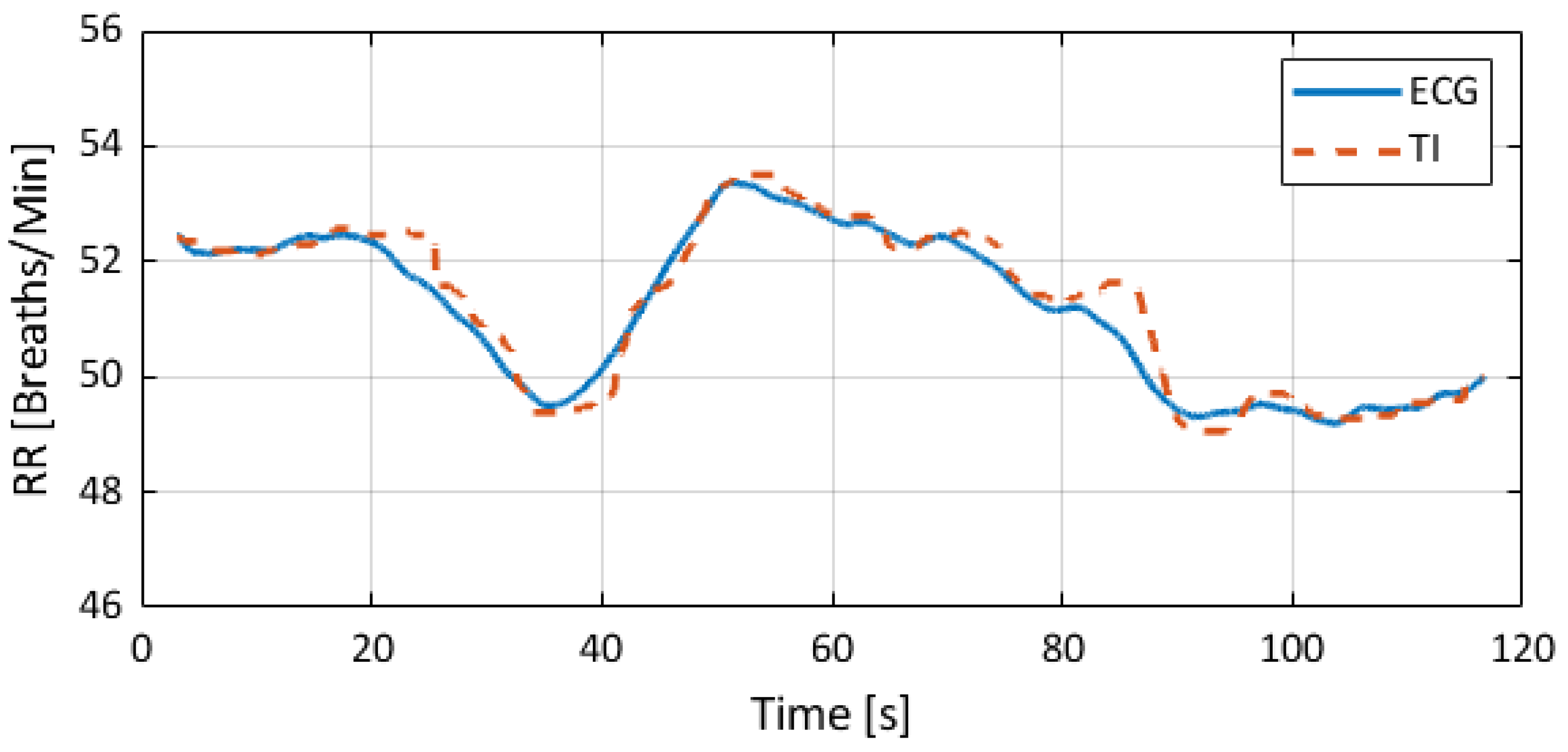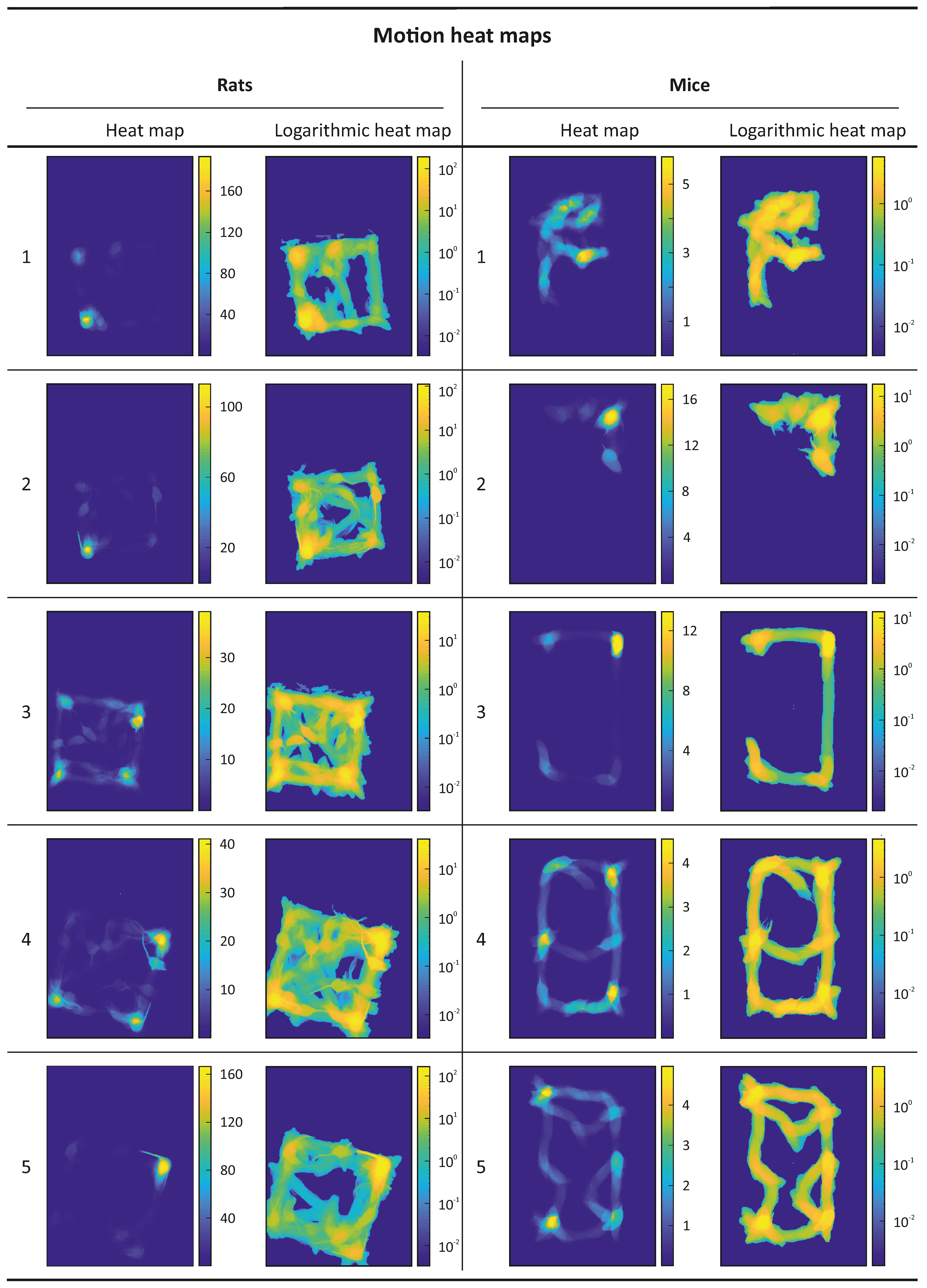Remote Welfare Monitoring of Rodents Using Thermal Imaging
Abstract
1. Introduction
2. Methods
2.1. Estimation of Respiratory Rate
2.1.1. Selection of Region of Interest
2.1.2. Image Preprocessing
2.1.3. Motion Tracking
2.1.4. Temporal Filtering
2.1.5. Principal Component Analysis Decomposition
2.1.6. Principal Component Selection
2.2. Assessment of Exploratory Behavior and General Activity
2.2.1. Selection of Region of Interest
2.2.2. Motion Tracking
2.2.3. Motion Parameters and Heat Maps
3. Experimental Protocol
3.1. Collection of Thermal Videos for Assessment of Respiratory Rate
3.2. Collection of Thermal Videos during Open Field Tests
4. Results
4.1. Estimation of Respiratory Rate
4.2. Assessment of Exploratory Behavior and General Activity
5. Discussion
6. Conclusions
Supplementary Materials
Author Contributions
Funding
Acknowledgments
Conflicts of Interest
Ethical Statements
Abbreviations
| Mean relative error | |
| 90th percentile of the relative errors | |
| CCD | Couple-Charged Device |
| CMOS | Complementary Metal-Oxide Semiconductor |
| ECG | Electrocardiography |
| FFT | Fast Fourier transform |
| FIR | Finite impulse response |
| GS | Gold standard |
| HR | Heart rate |
| IRT | Infrared thermography |
| OFT | Open Field test |
| PC | Principal component |
| PCA | Principal component analysis |
| PPG | Photoplethysmography |
| RMSE | Root-mean-square error |
| ROI | Region of interest |
| RR | Respiratory rate |
| SSE | Sum of the squared errors |
| TI | Thermal image |
References
- Festing, S.; Wilkinson, R. The ethics of animal research. Talking Point on the use of animals in scientific research. EMBO Rep. 2007, 8, 526–530. [Google Scholar] [CrossRef] [PubMed]
- Kehinde, E.O. They See a Rat, We Seek a Cure for Diseases: The Current Status of Animal Experimentation in Medical Practice. Med. Princ. Pract. 2013, 22, 52–61. [Google Scholar] [CrossRef] [PubMed]
- Barré-Sinoussi, F.; Montagutelli, X. Animal models are essential to biological research: Issues and perspectives. Future Sci. OA 2015, 1, FSO63. [Google Scholar] [CrossRef] [PubMed]
- National Academy of Sciences (US) and Institute of Medicine (US) Committee on the Use of Animals in Research. Science, Medicine, and Animals; The National Academies Press: Washington, DC, USA, 1991. [Google Scholar]
- Lothrop, C.D., Jr. Veterinary Medical Specialization. Adv. Veterinary Sci. Comp. Med. 1995, 39, 141–190. [Google Scholar]
- Levy, N. The Use of Animal as Models: Ethical Considerations. Int. J. Stroke 2012, 7, 440–442. [Google Scholar] [CrossRef] [PubMed]
- Kinter, L.B.; DeGeorge, J.J. Scientific Knowledge and Technology, Animal Experimentation, and Pharmaceutical Development. ILAR J. 2016, 57, 101–108. [Google Scholar] [CrossRef] [PubMed]
- Hajar, R. Animal Testing and Medicine. Heart Views 2011, 12, 42. [Google Scholar] [CrossRef] [PubMed]
- Roelfsema, P.; Treue, S. Basic Neuroscience Research with Nonhuman Primates: A Small but Indispensable Component of Biomedical Research. Neuron 2014, 82, 1200–1204. [Google Scholar] [CrossRef] [PubMed]
- Flecknell, P. Replacement, reduction and refinement. ALTEX 2002, 19, 73–78. [Google Scholar] [PubMed]
- Vainer, B.G. A Novel High-Resolution Method for the Respiration Rate and Breathing Waveforms Remote Monitoring. Ann. Biomed. Eng. 2018, 46, 960–971. [Google Scholar] [CrossRef] [PubMed]
- Niemeyer, J.E. Telemetry for small animal physiology. Lab Anim. 2016, 45, 255. [Google Scholar] [CrossRef] [PubMed]
- Barbosa Pereira, C.; Czaplik, M.; Blazek, V.; Leonhardt, S.; Teichmann, D. Monitoring of Cardiorespiratory Signals Using Thermal Imaging: A Pilot Study on Healthy Human Subjects. Sensors 2018, 18, 1541. [Google Scholar] [CrossRef] [PubMed]
- Kramer, K.; Kinter, L.; Brockway, B.P.; Voss, H.P.; Remie, R.; Van Zutphen, B.L. The use of radiotelemetry in small laboratory animals: Recent advances. Contemp. Top. Lab. Anim. Sci. 2001, 40, 8–16. [Google Scholar] [PubMed]
- Mutlu, K.; Rabell, J.E.; Martin del Olmo, P.; Haesler, S. IR thermography-based monitoring of respiration phase without image segmentation. J. Neurosci. Methods 2018, 301, 1–8. [Google Scholar] [CrossRef] [PubMed]
- González-Sánchez, C.; Fraile, J.C.; Pérez-Turiel, J.; Damm, E.; Schneider, J.G.; Zimmermann, H.; Schmitt, D.; Ihmig, F.R. Capacitive Sensing for Non-Invasive Breathing and Heart Monitoring in Non-Restrained, Non-Sedated Laboratory Mice. Sensors 2016, 16, 1052. [Google Scholar] [CrossRef] [PubMed]
- Garbey, M.; Sun, N.; Merla, A.; Pavlidis, I. Contact-free measurement of cardiac pulse based on the analysis of thermal imagery. IEEE Trans. Bio-Med. Eng. 2007, 54, 1418–1426. [Google Scholar] [CrossRef] [PubMed]
- Fei, J.; Pavlidis, I. Thermistor at a distance: Unobtrusive measurement of breathing. IEEE Trans. Bio-Med. Eng. 2010, 57, 988–998. [Google Scholar] [CrossRef]
- Pereira, C.B.; Yu, X.; Czaplik, M.; Rossaint, R.; Blazek, V.; Leonhardt, S. Remote monitoring of breathing dynamics using infrared thermography. Biomed. Opt. Express 2015, 6, 4378–4394. [Google Scholar] [CrossRef] [PubMed]
- Knobel, R.B.; Guenther, B.D.; Rice, H.E. Thermoregulation and thermography in neonatal physiology and disease. Biol. Res. Nurs. 2011, 13, 274–282. [Google Scholar] [CrossRef] [PubMed]
- Pereira, C.B.; Czaplik, M.; Blanik, N.; Rossaint, R.; Blazek, V.; Leonhardt, S. Contact-free monitoring of circulation and perfusion dynamics based on the analysis of thermal imagery. Biomed. Opt. Express 2014, 5, 1075–1089. [Google Scholar] [CrossRef] [PubMed]
- Vainer, B.G. FPA-based infrared thermography as applied to the study of cutaneous perspiration and stimulated vascular response in humans. Phys. Med. Biol. 2005, 50, R63–R94. [Google Scholar] [CrossRef] [PubMed]
- Cretikos, M.A.; Bellomo, R.; Hillman, K.; Chen, J.; Finfer, S.; Flabouris, A. Respiratory rate: The neglected vital sign. Med. J. Aust. 2008, 188, 657–659. [Google Scholar] [PubMed]
- Suzuki, M.; Millecamps, M.; Naso, L.; Ohtori, S.; Mori, C.; Stone, L.S. Chronic Osteoporotic Pain in Mice: Cutaneous and Deep Musculoskeletal Pain Are Partially Independent of Bone Resorption and Differentially Sensitive to Pharmacological Interventions. J. Osteoporos. 2017, 2017, 7582716. [Google Scholar] [CrossRef] [PubMed]
- Gould, T.D.; Dao, D.T.; Kovacsics, C.E. The Open Field Test. In Mood and Anxiety Related Phenotypes in Mice: Characterization Using Behavioral Tests, 1st ed.; Gould, T.D., Ed.; Humana Press: Totowa, NJ, USA, 2009. [Google Scholar]
- Otsu, N. A Threshold Selection Method from Gray-Level Histograms. IEEE Trans. Syst. Man Cybern. 1979, 9, 62–66. [Google Scholar] [CrossRef]
- Shi, J.; Tomasi, C. Good features to track. In Proceedings of the IEEE Conference on Computer Vision and Pattern Recognition, Seattle, WA, USA, 21–23 June 1994; pp. 593–600. [Google Scholar] [CrossRef]
- Quesenberry, K.; Carpenter, J.W. Ferrets, Rabbits and Rodents-E-Book: Clinical Medicine and Surgery; Elsevier Health Sciences: Amsterdam, The Netherlands, 2011. [Google Scholar]
- Jolliffe, I.T. Principal Component Analysis; Springer Science & Business Media: Berlin/Heidelberg, Germany, 2002. [Google Scholar]
- Mei, X.; Ling, H. Robust visual tracking and vehicle classification via sparse representation. IEEE Trans. Pattern Anal. Mach. Intell. 2011, 33, 2259–2272. [Google Scholar] [CrossRef] [PubMed]






| Rodent ID | Mean RR (Breaths/Min) | RMSE | (%) | (%) | Correlation | |
|---|---|---|---|---|---|---|
| GS | TI | (Breaths/Min) | ||||
| R1 | 51.17 | 51.27 | 0.32 | 0.44 | 0.92 | 0.98 |
| R2 | 53.58 | 53.58 | 0.21 | 0.28 | 0.66 | 0.96 |
| R3 | 43.57 | 43.70 | 0.38 | 0.52 | 1.05 | 0.95 |
| R4 | 49.38 | 49.53 | 0.42 | 0.67 | 1.54 | 0.98 |
| R5 | 61.54 | 61.69 | 0.43 | 0.57 | 1.08 | 0.97 |
| Mean ± SD | 51.85 ± 6.56 | 51.95 ± 6.56 | 0.35 ± 0.09 | 0.50 ± 0.15 | 1.05 ± 0.32 | 0.97 ± 0.01 |
| Rodent ID | Mean RR (Breaths/Min) | (%) | |
|---|---|---|---|
| GS | TI | ||
| M1 | 130.00 | 131.46 | 1.12 |
| M2 | 132.00 | 144.13 | 9.19 |
| M3 | 70.00 | 67.41 | 3.70 |
| M4 | 96.00 | 99.69 | 3.84 |
| M5 | 139.00 | 145.81 | 4.90 |
| Mean ± SD | 113.40 ± 29.42 | 117.70 ± 33.66 | 4.55 ± 2.94 |
© 2018 by the authors. Licensee MDPI, Basel, Switzerland. This article is an open access article distributed under the terms and conditions of the Creative Commons Attribution (CC BY) license (http://creativecommons.org/licenses/by/4.0/).
Share and Cite
Barbosa Pereira, C.; Kunczik, J.; Zieglowski, L.; Tolba, R.; Abdelrahman, A.; Zechner, D.; Vollmar, B.; Janssen, H.; Thum, T.; Czaplik, M. Remote Welfare Monitoring of Rodents Using Thermal Imaging. Sensors 2018, 18, 3653. https://doi.org/10.3390/s18113653
Barbosa Pereira C, Kunczik J, Zieglowski L, Tolba R, Abdelrahman A, Zechner D, Vollmar B, Janssen H, Thum T, Czaplik M. Remote Welfare Monitoring of Rodents Using Thermal Imaging. Sensors. 2018; 18(11):3653. https://doi.org/10.3390/s18113653
Chicago/Turabian StyleBarbosa Pereira, Carina, Janosch Kunczik, Leonie Zieglowski, René Tolba, Ahmed Abdelrahman, Dietmar Zechner, Brigitte Vollmar, Heike Janssen, Thomas Thum, and Michael Czaplik. 2018. "Remote Welfare Monitoring of Rodents Using Thermal Imaging" Sensors 18, no. 11: 3653. https://doi.org/10.3390/s18113653
APA StyleBarbosa Pereira, C., Kunczik, J., Zieglowski, L., Tolba, R., Abdelrahman, A., Zechner, D., Vollmar, B., Janssen, H., Thum, T., & Czaplik, M. (2018). Remote Welfare Monitoring of Rodents Using Thermal Imaging. Sensors, 18(11), 3653. https://doi.org/10.3390/s18113653








